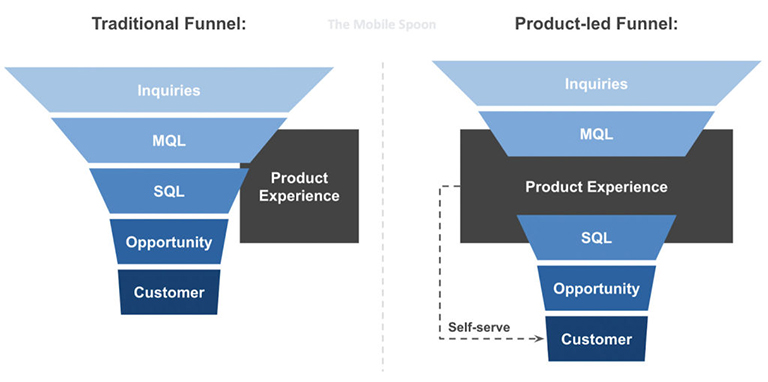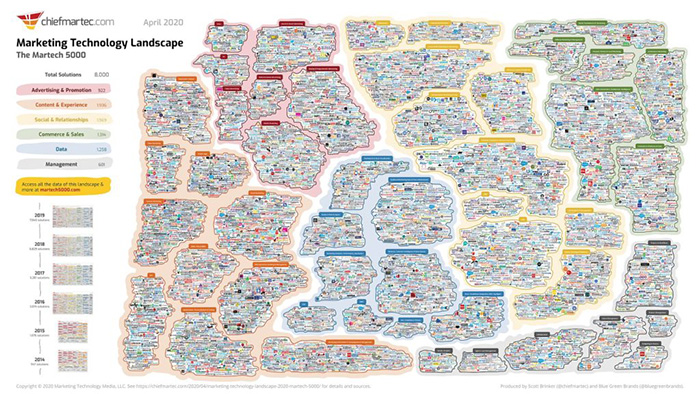If you want to build a product-led tech stack or evaluate your current one, I’d recommend starting at the top of your funnel. Then, map out any gaps that your current stack has against the core components of the PLG MarTech stack.
Over the past few years, B2B SaaS companies have been transitioning from more traditional sales-led GTM motions to a more product-led approach. As a result, GTM teams, their success metrics, and supporting technologies are starting to look very different.
by Jacob Levinger
In this post, I’ll unpack the key differences between sales-led and product-led funnels. In doing so, I’ll explore what it looks like to build a strong Marketing Technology (MarTech) stack for a product-led funnel, along with how to evaluate your own tech stack.
A tale of two funnels: sales-led vs. product-led

Rather than break down the strategic differences between sales-led and product-led motions, let’s focus on how marketing operations work in both circumstances. (To learn more about the high-level differences, check out this article.)
With marketing operations, the shift from human-centric to product-centric touchpoints has a large impact on how you approach each user.
To clarify this further, let’s explore the differences at the top of the funnel:
- Lead Generation
- Lead Quality
Lead generation
Sales-led companies typically encourage users to fill out marketing intake forms on the site (e.g. “Request a demo” forms) to drive inbound leads before users can try out the product. Sometimes, these companies also use outbound sales tactics to acquire leads and build the sales pipeline.
In contrast, product-led companies typically optimize the website with a free trial or freemium signup flow to drive people into the product. They generate inbound leads for sales only after the user has expressed interest in the product.
Lead quality
Sales-led companies use first-party data collected via forms and tend to enrich it with third-party firmographic data from providers like Clearbit or ZoomInfo. They can also add marketing behavioral data—like webinars attended, whitepapers downloaded, etc.
First and third-party data are still vital for product-led companies, but the key difference is that product usage data becomes an immensely valuable behavioral vector to use when grading the quality of leads in the funnel.
As you can see, the differences between these funnels—no matter how small—have a big impact on the data you collect and what’s important to move leads into paying customers. This has far-reaching implications for the MarTech stack you use to support your funnel.
The building blocks of a product-led MarTech stack
Now let’s get to the meat and potatoes of this discussion—the ideal PLG MarTech Stack.
Sure, both motions will have a lot of technology overlap, but there are a few new players on the product-led side that you wouldn’t normally encounter at sales-led companies.
It’s also worth noting that the MarTech landscape is HUGE, and I’m not going to focus on every piece of your tech stack. Rather, I’ll keep my focus on the bedrock components.

Customer data platform: the product data capturer
For any product-led company, a customer data platform (CDP) is a must-have. This is the tool that captures all product signups and actual usage data, standardizes them, and then distributes it to any number of data destinations.
After being piped into destination systems, the events themselves can be used in a variety of ways.
For example, you can pass trial signup events to your marketing system to then send timely trial activation emails. Or you can ascribe data into your warehouse and write queries against it to learn if certain product usage signals correlate to the likelihood a lead will convert into a paying customer.
Here are examples of top CDPs:
Marketing automation platform: the marketing team’s one-stop-shop
A marketing automation platform is the most integral part of any MarTech stack. It is the foundation that all marketing campaigns are built on. (Think email drips, webinars, content downloads, lead capture forms.)
It should also be a key operational hub for managing data hygiene, lead quality, automation triggers, and even MQL criteria.
Examples of this include:
CRM: the GTM team’s source of truth
A Customer Relationship Management (CRM) tool is not only a critical component of any B2B SaaS company but also their product-led growth MarTech stack.
The CRM should always be your source of truth for any and all leads that make it into your B2B funnel. It should be configured to allow Marketing to pull reports on the leads and MQLs going into it. It’s also built to contain processes and SLAs to empower the sales team to actually work those MQLs.
Examples of CRM tools:
Data enrichment provider: the real-time lead enrichment lever
A third-party data enrichment tool is not as necessary as a CRM or marketing automation platform, but it’s incredibly valuable for any B2B business—especially if it’s product-led. This is primarily because your free trial signup form usually involves fewer required fields to complete than a Request a Demo form.
When you’re only collecting names and emails, it’s hard to know if the lead is someone of high value at first glance. Having an enrichment tool that can look up the lead against a database and append company information (employee count, funding raised, etc.) as well as person-level data (job title, phone number, etc.) can uncover more valuable leads within your signups.
Here are some examples:
Data warehouse: the product data source of truth
Admittedly, architecting and managing data warehouses aren’t my strong suit, but in my time working at a PLG company I’ve learned how truly powerful they are, not just for Data, Engineering, and Product teams but also for GTM teams.
At the highest level, your data warehouse should be the source of truth for your product data. At a bare minimum, it should have logs of every trial signup and customer, the organizations they’re associated with, and the rich product usage data.
Here are some examples of a data warehouse:
Having this data captured and structured is immensely valuable, but I’ve learned from experience that this rich data often lives in a silo.
Any product data not interacting at scale with your GTM systems (e.g. Hubspot and Salesforce) can put a damper on your hopes of using product data to augment and enrich your leads for purposes such as MQL criteria.
That’s where the final piece of the tech stack comes in.
Reverse-ETL: the bridge between the data warehouse and your GTM tech
The concept of Reverse-ETL and some of the popular providers is relatively nascent, but in the short time it’s popped up it has proven to be immensely valuable for PLG companies.
At its core, Reverse-ETL tools work by letting you write queries against your data warehouse to pull records and then match against records in your business systems (e.g. Hubspot) for the purpose of appending data.
Here’s a step-by-step example of how this would work:
- Write a query against your data warehouse to show all trial signups that have logged in more than 5 times in the past month.
- Pull a unique identifier into your query (usually email or user ID) and use it to match the query results to real leads in a tool like Hubspot or Salesforce.
- Designate a column in your query to identify these results in your business system. It could be as simple as a checkbox on the Hubspot lead called “multiple logins in the past month” and set it to true for use in workflows and smart lists.
This is incredibly powerful because it breaks down the silo of data warehouses and business systems and replaces exporting and uploading CSVs by hand with a much more scalable, programmatic, and high fidelity process.
Here are some examples of Reverse-ETL tools:
How an actual PLG MarTech stack works in the wild
The examples above are all good at a high level, but I’d like to share context on how we put this entire tech stack together here at Retool.
For context, Retool is a platform that allows developers to quickly build internal apps by connecting any data source and creating a custom frontend using pre-built UI components.
As a result, we’re a developer-centric product-led company—and our tech stack uses each of the tech tools described above to power our GTM motion.
Here’s how this works in practice:
- A lead comes to our site and signs up for a Retool free trial with their first name, last name, and email. This is tracked in Segment which then creates a new record directly in BigQuery and in Hubspot.
- Once this user is created in Hubspot, Clearbit enriches the signup by looking up the email in their database. If we find a match, we populate the job title, company, company size, and website.
- Next, we use the signup lead creation as a trigger to send our Trial Activation Email Drip, which onboards the user as they start using our product.
- After this email is sent, we evaluate the freshly enriched lead against a custom-built MQL model that looks at behavioral information (company size, job title, etc.) and most importantly product usage data (inviting users, creating Retool apps, etc.)
- If the lead meets our MQL criteria, we mark it as an MQL in Salesforce and auto-route it to the sales team to contact them. The sales team reaches out to help them onboard alongside the drip and learn if there is an Enterprise use case.
- For all other leads that don’t MQL right away, we let them continue to receive the trial activation emails and use the product as they need. We capture all of this product usage data in Segment and pass it into Hubspot and BigQuery.
- In the background, we have SQL queries written in our Reverse-ETL tool (Hightouch) that run on a set timeline and append relevant product usage computations to leads in Hubspot and SFDC to trigger more advanced onboarding and also provide the sales team with more information on the MQLs they’re currently reaching out to.

How to start building your own PLG stack
If you take away nothing else from this article, you should now know that:
- If you’re a product-led company, you can and must make use of your product usage data to grow your business.
- The tools exist to create a powerful MarTech stack to draw out the full potential of your product data and grow your business.
If you want to build a product-led MarTech stack or evaluate your current one, I’d recommend starting at the top of your funnel. Then, map out any gaps that your current stack has against the core components of the PLG MarTech stack.
Remember: your product usage data is worth its weight in gold, and the MarTech space has evolved over the past few years to equip you to build a system to extract, refine, and act upon this data.
This article originally appeared in ProductLed. Photo by Crissy Jarvis on Unsplash.












